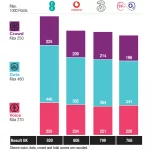Openreach Extend Low Level Error Correction to New 80Mbps FTTC Lines
Consumers adopting one of Openreach’s 80Mbps Fibre-to-the-Cabinet (FTTC / VDSL2) based UK broadband ISP lines (usually advertised with average speeds of c.60-65Mbps) are likely to create fewer fault reports during the initial provision phase after the new “low level error correction” feature began being applied to them.
The roll-out of this feature actually began back in February 2018 (here), although at the time it was only deployed to the operator’s slower 40Mbps and 55Mbps product tiers (this wasn’t stated in their public briefing). This week it also began being extended to their top 80Mbps product tier on the same VDSL2 based broadband service.
Normally a Dynamic Line Management (DLM) system is used to control the speed and stability of these lines (your speed may go up or down depending upon how stable DLM thinks the line is), but after first provision (i.e. new installation) it usually takes about 48 hours before this is introduced so that everything can be correctly calibrated. As such new lines go through a period with no error correction being applied and their speed capped.
Advertisement
As Openreach explains, “This can lead to customer(s) raising faults before DLM starts working due to excessive data errors which impact their broadband service.” The solution that they’ve developed is to temporarily apply a low level of error correction during the first 48 hours, before DLM kicks in properly, which helps to mitigate the aforementioned problems.
Mark is a professional technology writer, IT consultant and computer engineer from Dorset (England), he also founded ISPreview in 1999 and enjoys analysing the latest telecoms and broadband developments. Find me on X (Twitter), Mastodon, Facebook, BlueSky, Threads.net and Linkedin.
« Sheffield, Newcastle and Gateshead Get BT InLinkUK Gigabit WiFi Kiosks


















































Comments are closed